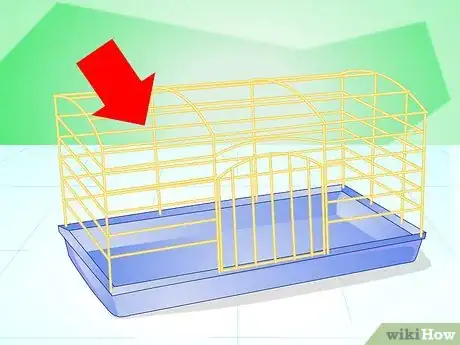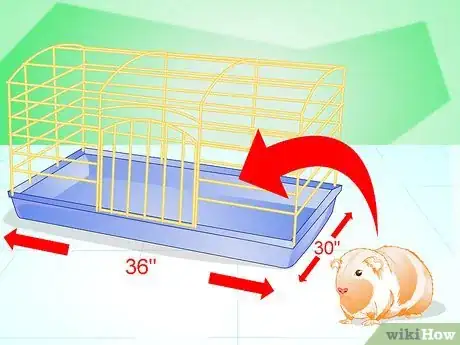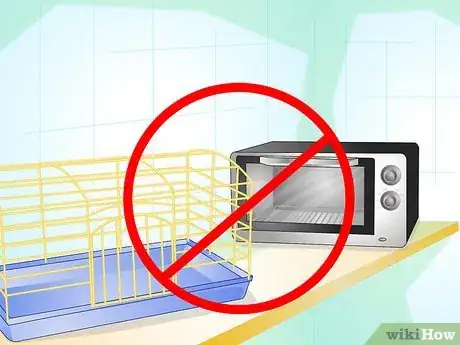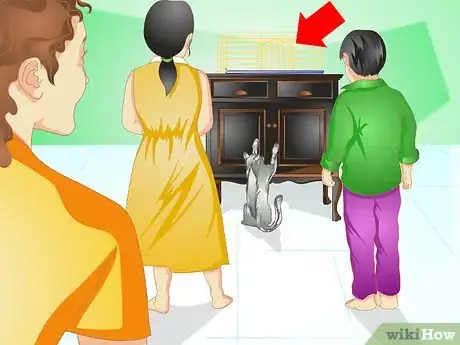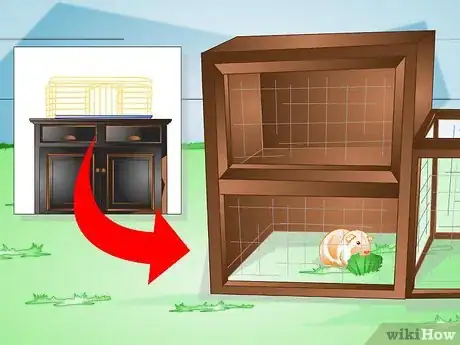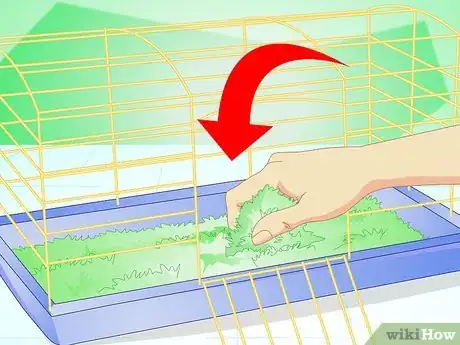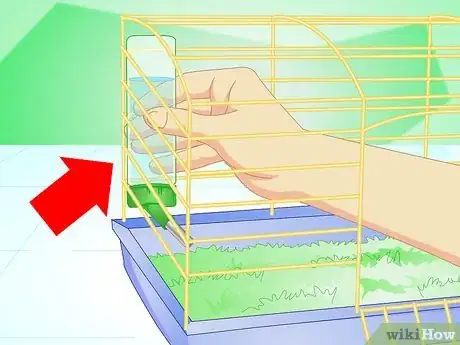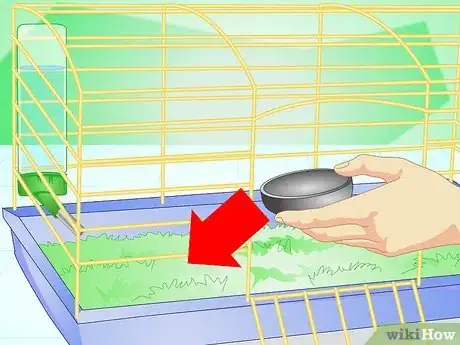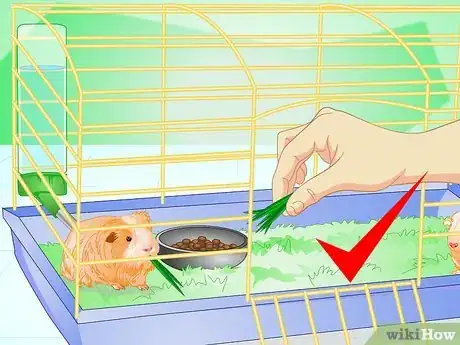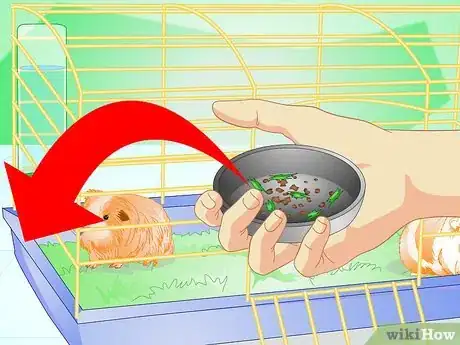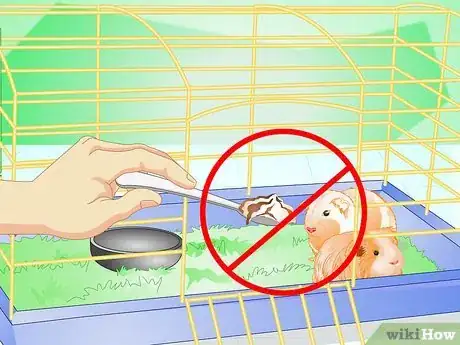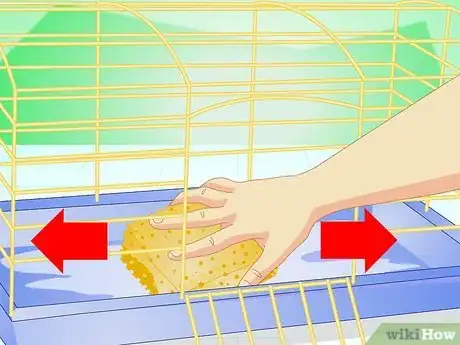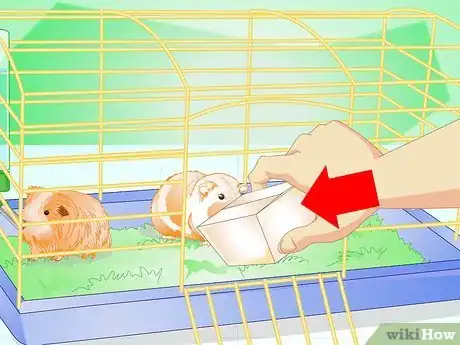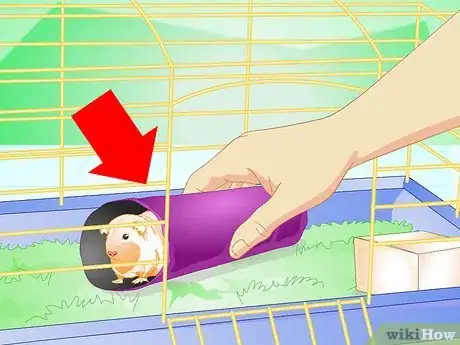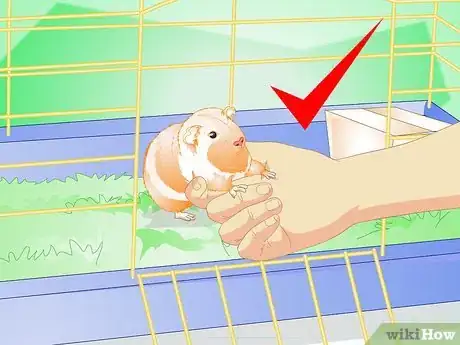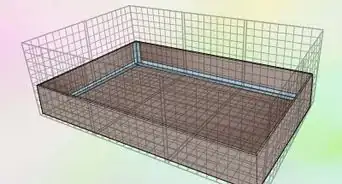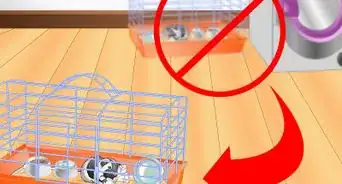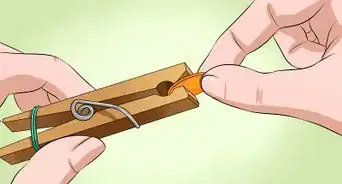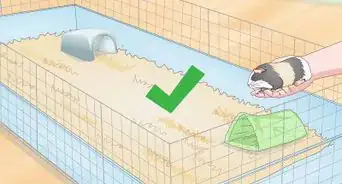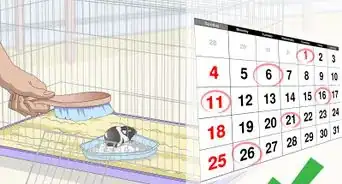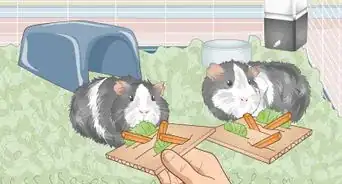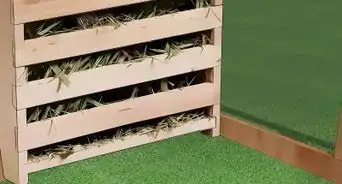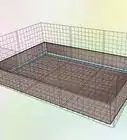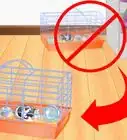This article was co-authored by Pippa Elliott, MRCVS. Dr. Elliott, BVMS, MRCVS is a veterinarian with over 30 years of experience in veterinary surgery and companion animal practice. She graduated from the University of Glasgow in 1987 with a degree in veterinary medicine and surgery. She has worked at the same animal clinic in her hometown for over 20 years.
There are 8 references cited in this article, which can be found at the bottom of the page.
wikiHow marks an article as reader-approved once it receives enough positive feedback. This article received 12 testimonials and 83% of readers who voted found it helpful, earning it our reader-approved status.
This article has been viewed 235,495 times.
Guinea pigs are small animals that make fun and lively pets. Since guinea pigs spend a lot of time in their cages, it's important to make sure that you have the right size cage and that it is properly outfitted with everything needed to make your guinea pig happy and healthy, including food, water, bedding, and entertainment.
Steps
Selecting and Placing a Cage
-
1Consider the size of the cage. The Humane Society of the United States has noted that most cages available on the market for guinea pigs are simply too small. In fact, most cages are instead meant to house smaller animals like hamsters and gerbils.[1]
- Unlike some other animals, guinea pigs need floor space, not vertical space. Since they cannot use running wheels, they need ample room to move around and exercise in order to stay healthy.
- A cage that is too small for a guinea pig (under 7.5 square feet) can cause the animal to become bored and depressed. Imagine if you had to spend your entire life living in a closet with little room for activity and stimulation.
- Guinea pig cages that are too small have also been linked to the development of certain medical conditions. They are more likely to get pododermatitis (the equivalent of bed sores, but on their hocks) as a result of sitting still on soiled bedding.
- Larger cages are also better if you have more than one guinea pig so that each pet can have its own personal space.
- Larger cages also have benefits for you as well! They're easier to clean because they enable guinea pigs to separate their "bathroom" space from their other living areas.
-
2Follow the appropriate size guidelines. Typically, the recommended standard cage size is about 2 square feet per guinea pig. However, this is insufficient, as there is not enough room for everything a guinea pig needs, including food, water dish, nest, and bathroom area. Guinea Pigs need more room than other animals, because they cannot use the running wheels. Instead, they need space to exercise. Consider the following guidelines, which provide more space and consider the number of pigs in the cage:[2]
- 1 guinea pig - 7.5 square feet (0.75m2) minimum size. More is advised. Aim for a cage that is 30" x 36" (75cm x 100cm)
- 2 guinea pigs - 7.5 square feet (0.75m2) cage (minimum). However, 10.5 square feet (1m2) is advised. Aim for a cage that is 30" x 60” (75cm x 150cm).
- 3 guinea pigs - 10.5 square feet (1m2) cage (minimum). However, 13 square feet (1.25m2) feet is advised. Look for a cage that is 30" x 76” (75cm x 190cm).
- 4 guinea pigs - 13 square feet (1.25m2) cage (minimum). However, more space is advisable and you should look for a cage about 30" x 90” (75cm x 225cm).
Advertisement -
3Think about the location of the cage in your home. Where you place the cage in your home is very important. For sanitary reasons, avoid keeping the cage in or very near to the kitchen. You'll need to consider several factors in order to determine the right spot, including:[3]
- Temperature - Make sure to keep your guinea pig cage away from extreme temperatures because the animals don't like very cold, warm and humid temperatures and can become ill. The ideal temperature for a guinea pig cage is about 65-75℉ (18-24℃). Keep the cage away from drafty spaces like doors and windows and place it on an elevated surface.[4]
- Activity - Guinea pigs enjoy being near family activity and benefit from more attention when they’re easy to see and hear. A family room or living room works well, but make sure your pigs have a place to retreat if they need some quiet time.[5]
- Noise - Guinea pigs have very sensitive hearing and their cages should not be placed next to stereos, televisions or other loud noises.[6]
-
4Keep the cage safe from children and other pets. Put the cage in an area in your home where you can supervise interactions between your children and the guinea pig so that your guinea pig does not escape or get injured. Similarly, keep your pig safe from any pets (especially cats and dogs) by keeping the cage inaccessible to curious pets.[7] [8]
-
5Choose a safe spot either inside or outside. Some people choose to keep guinea pigs indoors, where they are safe from extreme weather and predatory animals, while others prefer to keep them in outdoor hutches.[9] If you choose to keep your guinea pig indoors, attempt to get your pet out into the sunshine regularly to aid Vitamin D synthesis for healthy bones and teeth. If you have an outdoor hutch, the guinea pig requires daily attention from the owner. Bring your pet inside in extremes of weather.[10]
- In addition, guinea pigs are social animals and thrive when they are able to interact with humans. Keeping them outdoors limits opportunities for daily socialization.
Providing the Basics
-
1Put some bedding in the cage. Do not use cedar or pine shavings as bedding, even though these are widely available as bedding for small pets. These materials have phenol, which can be harmful to guinea pigs. Instead, buy bedding made of paper or straw, as it retains heat and keeps the pig warm. Guinea pigs like to burrow into their bedding and make tunnels. Make sure to provide about 2-3 inches worth of bedding, so that there is sufficient absorption.[11]
- Change bedding weekly and spot clean daily if it becomes wet or sodden. Guinea pigs prefer clean, dry bedding.
-
2Provide water. To keep your guinea pig healthy and happy, make sure to provide it with clean, fresh water. In general, a sipper bottle is a better option than a water dish because it doesn't spill as easily or become soiled with other material in the cage (such as food bedding, etc.).[12]
- Look for a 32 ounce glass water bottle. You can also purchase a plastic bottle, which is more easily available in most pet stores. Place the bottle so that it hangs off the side of the cage and it easily in reach of your guinea pig.
- Provide your guinea pig with fresh water every day (even if the bottle hasn't been drained). Wash the bottle each week when you clean the cage. You might want to use a bottle brush to scrub the bottle in case there are any hard-to-remove particles or substances. You can also use a Q-Tip to clean the nozzle of the water bottle to make sure that the sipper works properly and is not blocked.
-
3Put a food bowl in the cage. Like all animals, guinea pigs need sustenance to survive. Try to choose a ceramic food bowl, rather than a plastic bowl. Ceramic dishes are harder to topple and are chew-resistant. They're also more durable than plastic bowls.[13]
- Choose a wide and shallow bowl that will allow the guinea pig to put its front feet on the rim of the bowl. This is typically how guinea pigs like to eat.
- Make sure the food bowl is placed far away from its bathroom area for sanitary reasons.
- Clean the bowl as needed if your pet kicks bedding or droppings into it.
-
4Put food in the cage. Though guinea pigs rarely overeat, you need to provide them with the right balance of pellets, hay, and fresh vegetables.[14]
- Hay - Hay is key to your guinea pig's diet. Hay provides a key source of fiber and serves both serves as food and bedding. It also aids the digestive systems of guinea pigs. Choose fresh bags of timothy hay, although orchard hay is also an option.[15]
- Pellets - To make sure that your guinea pig gets all of the nutrients it needs, provide it with a commercial feed specifically for guinea pigs. Give a small amount of extruded pellets (all the nuggets look the same) about a teaspoon a day. Pellets should come second to hay, which they need to chew to keep their teeth from growing out of control. Getting all of their calories from pellets will lead to overgrown teeth, or cause them to become obese. Purchase pellets made from timothy hay, rather than alfalfa hay. These pellets will be fortified with vitamin C, but since it degrades once the package is opened, it's important to supplement with vegetables high in vitamin C.[16]
- Vegetables - Veggies are a key source of vitamin C for guinea pigs and give them additional nutrients. They also help vary your pet's meal choices and make eating more exciting. Try to choose leafy greens like kale, mustard greens, spinach, and romaine lettuce, because these are high in vitamin C. Other fresh veggie options include bell peppers, brussel sprouts, carrots, cucumbers, peas, and tomatoes, among others. Try experimenting and seeing what your guinea pig likes! Note that some vegetables can cause gas build-up guinea pigs' digestive system and should be fed only in small quantities and from time to time. These include bok choy, broccoli, cabbage, cauliflower, and collard greens.[17]
- Fruits - Guinea pigs love fruit! Try to choose fruits high in vitamin C, like cantaloupe, strawberries, kiwi, and papaya. However, because fruit is high in sugar, provide it only in limited quantities and just a few times per week. Fruit should never amount to more than 10% of your guinea pig's diet.[18] Use caution when feeding your guinea pig apples as the acid in apples can sometimes cause allergic reactions (look for sores and scabs around your pig's mouth).
-
5Keep the food fresh. Because a guinea pig's diet includes a large amount of fresh produce means that you have to be checking the cage constantly and removing anything that is uneaten and can perish or decompose. A good rule of thumb is to check for unfinished food about an hour after you've put them in the cage.[19]
- Be sure to supplement the pellets with produce high in vitamin C. Once the bag of food is opened the vitamin C starts to degrade, so it's important not to rely solely on formulated food to provide vitamin C. Similarly, make sure to check the milling date of guinea pig pellets. Dispose of any remaining pellets after three months past this date.
-
6Avoid feeding your guinea other foods. Certain foods can cause digestive problems in guinea pigs. One way to tell if a food is adversely affecting your guinea pig is if you notice it producing soft stools or even diarrhea. In general, avoid feeding your guinea pig dairy products, beans, garlic, raw and dried lentils, onions, potatoes, and rhubarb.[20]
- Avoid chewy and sticky foods, such as peanut butter, which can cause your guinea pig to choke. Other choking hazards include nuts and seeds.
- Avoid foods with sharp edges, like crackers or chips, because these can puncture your guinea pig's mouth.
- Avoid feeding your guinea pig all processed and junk foods, including chocolate and candy.
- Commercial treats aren't needed if you're feeding your guinea pig the right mix of pellets, hay, and fruits and vegetables. If you want to give your pig a special treat, you could mix some rolled oats into the pellets.[21]
-
7Clean the cage regularly. Cages should be spot-cleaned everyday and completely cleaned once a week.[22]
- Everyday make sure your remove any uneaten food and provide fresh water. Clean out any food pellets or droppings that aren't where they should be.
- Once a week you should replace the dirty bedding and thoroughly clean out the cage. Remove everything inside and scrub the bottom of the cage with warm water. Make sure to dry everything before adding fresh bedding. Clean the cage completely once a week by replacing dirty bedding and scrubbing the bottom of the cage with warm water. Be sure everything’s dry before adding fresh bedding.
-
8Ensure that your guinea pig has a companion. Guinea pigs are naturally social animals, and having two guinea pigs isn't all that much work than owning one.
- Owning more than one guinea pig means that your guinea pig will not become as bored when you are unavailable to socialize with them.
- Two guinea pigs require the same amount of space as one (7.5 square feet).
- Having a companion can make your guinea pigs become more confident and trusting. It is generally easier to handle a guinea pig when they feel safe and more confident.
Providing Comfort and Entertainment
-
1Put some toys in the cage. Wooden blocks or cardboard boxes are good choices because guinea pigs like to gnaw on things; guinea pigs' teeth never stop growing, meaning that chew toys can help keep the teeth at a comfortable length. You can easily find wooden blocks at pet stores like Petsmart. Be sure to avoid purchasing wooden blocks or other toys with any paint on them.[23]
- You can also make homemade toys using items around the house, including paper bags, boxes, toilet rolls, etc.
- Make sure to only add large toys into the cage. Small toys can be choking hazards if swallowed by your animal.
- Add a hammock. Another bonus addition to outfit a guinea pig cage is a hammock, which can be found at stores like Petsmart. Though hammocks are mainly for ferrets, they can also be used for guinea pigs. However, be sure to observe your guinea pig once you install the hammock to make sure it is safe.
-
2Provide privacy. Put a little hut or tunnel in your guinea pig's cage. Each guinea pig needs its own hide to shelter in and have privacy.Guinea pigs can be extremely shy and they love to hide under things and get a little privacy. Again, these are things that you can either purchase at any main pet supply retailer or make inexpensively at home.
- For example, you could buy a tube/tunnel from a pet store, but for a lot less money, you can make your at home using an empty Quaker Oats container. Be sure to remove the plastic and metal lips from both ends and all labels. To make a little "house" where your pig can hide, use an old, plain (i.e., no dyes) shoe box. Your pig will love the little house and it's totally safe for chewing.
-
3Provide love and attention. Even when your guinea pig is inside the cage, show it attention. Guinea pigs love to interact with humans. Showering your pet with love and attention is one way to help your animal settle into the cage and feel comfortable.
- Interact with your guinea pig several times every day. It's important that you handle your guinea pig daily, touching and cuddling him as often as you can. You can also let him out of the cage and let him get additional exercise by running around a small room or other enclosed space; this is also something you should try to incorporate into your pig's daily routine. Make sure to only let your guinea pig out in rooms that have no small openings through which the guinea pig could escape or become lost. You'll also need to keep a close eye on your pig because guinea pigs will chew on anything they can, including dangerous items like electrical wires and cords.[24]
- Because of their social nature, guinea pigs are happier when living with another guinea pig (or more). So if you want your pig to have even more companionship, consider getting another one!
Expert Q&A
Did you know you can get expert answers for this article?
Unlock expert answers by supporting wikiHow
-
QuestionIs it essential to keep two guinea pigs and not just one?
 Pippa Elliott, MRCVSDr. Elliott, BVMS, MRCVS is a veterinarian with over 30 years of experience in veterinary surgery and companion animal practice. She graduated from the University of Glasgow in 1987 with a degree in veterinary medicine and surgery. She has worked at the same animal clinic in her hometown for over 20 years.
Pippa Elliott, MRCVSDr. Elliott, BVMS, MRCVS is a veterinarian with over 30 years of experience in veterinary surgery and companion animal practice. She graduated from the University of Glasgow in 1987 with a degree in veterinary medicine and surgery. She has worked at the same animal clinic in her hometown for over 20 years.
Veterinarian Yes, but you need to give the lone guinea pig lots of attention. Guinea pigs are social animals and love being in a community. Keeping more than one guinea pig means they always have social interaction going on. When keeping one guinea pig, you need to be their companion, so it's essential to play regularly (several times a day) cuddle, and handle the pig two or three times a day minimum, in order to provide for that need.
Yes, but you need to give the lone guinea pig lots of attention. Guinea pigs are social animals and love being in a community. Keeping more than one guinea pig means they always have social interaction going on. When keeping one guinea pig, you need to be their companion, so it's essential to play regularly (several times a day) cuddle, and handle the pig two or three times a day minimum, in order to provide for that need. -
QuestionIf I can't afford bedding can I use grass?
 Pippa Elliott, MRCVSDr. Elliott, BVMS, MRCVS is a veterinarian with over 30 years of experience in veterinary surgery and companion animal practice. She graduated from the University of Glasgow in 1987 with a degree in veterinary medicine and surgery. She has worked at the same animal clinic in her hometown for over 20 years.
Pippa Elliott, MRCVSDr. Elliott, BVMS, MRCVS is a veterinarian with over 30 years of experience in veterinary surgery and companion animal practice. She graduated from the University of Glasgow in 1987 with a degree in veterinary medicine and surgery. She has worked at the same animal clinic in her hometown for over 20 years.
Veterinarian Yes and no. Siting a run on fresh growing grass is ideal in the summer months as it doubles as a comfortable substrate and food. Move the run daily so that it doesn't become muddy or soiled. However, cut grass starts to ferment and can cause gastric disturbances and bloat. This means it's not ideal for bedding, neither is it particularly warm and insulatory when the weather gets cold. Try using shredded paper from your recycling on the floor of the hutch. Also, consider providing a large cardboard box filled with straw for the guinea pig to sleep in, rather than fill the entire hutch with straw.
Yes and no. Siting a run on fresh growing grass is ideal in the summer months as it doubles as a comfortable substrate and food. Move the run daily so that it doesn't become muddy or soiled. However, cut grass starts to ferment and can cause gastric disturbances and bloat. This means it's not ideal for bedding, neither is it particularly warm and insulatory when the weather gets cold. Try using shredded paper from your recycling on the floor of the hutch. Also, consider providing a large cardboard box filled with straw for the guinea pig to sleep in, rather than fill the entire hutch with straw.
Warnings
- Make sure your guinea pig cannot put anything hazardous in their mouth. Anything that is a choking hazard does not belong in your guinea pig's cage.⧼thumbs_response⧽
- Make sure the cage is big enough for the following things: something for your guinea pig to hide in or under, food bowl, a place for your guinea pig to go to the bathroom, and enough space for it to run around.⧼thumbs_response⧽
References
- ↑ http://www.humanesociety.org/animals/guinea_pigs/tips/guinea_pig_housing.html?credit=web_id81806465
- ↑ http://www.humanesociety.org/animals/guinea_pigs/tips/guinea_pig_housing.html?credit=web_id81806465
- ↑ http://www.humanesociety.org/animals/guinea_pigs/tips/guinea_pig_housing.html?credit=web_id81806465
- ↑ http://www.humanesociety.org/animals/guinea_pigs/tips/guinea_pig_housing.html?credit=web_id81806465
- ↑ http://www.humanesociety.org/animals/guinea_pigs/tips/guinea_pig_housing.html?credit=web_id81806465
- ↑ http://www.humanesociety.org/animals/guinea_pigs/tips/guinea_pig_housing.html?credit=web_id81806465
- ↑ http://www.humanesociety.org/animals/guinea_pigs/tips/guinea_pig_housing.html?credit=web_id81806465
- ↑ http://pets.petsmart.com/guides/guinea-pigs/caring-guinea-pig.shtml
- ↑ http://www.humanesociety.org/animals/guinea_pigs/tips/guinea_pig_housing.html?credit=web_id81806465
- ↑ http://www.rspca.org.uk/adviceandwelfare/pets/rodents/guineapigs/environment
- ↑ https://www.aspca.org/pet-care/small-pet-care/guinea-pig-care
- ↑ http://www.humanesociety.org/animals/guinea_pigs/tips/water_bottles.html?credit=web_id81806465
- ↑ http://www.humanesociety.org/animals/guinea_pigs/tips/guinea_pig_feeding.html?credit=web_id104983548
- ↑ http://www.humanesociety.org/animals/guinea_pigs/tips/guinea_pig_feeding.html?credit=web_id104983548
- ↑ http://www.humanesociety.org/animals/guinea_pigs/tips/guinea_pig_food_choices.html?credit=web_id104983548
- ↑ http://www.humanesociety.org/animals/guinea_pigs/tips/guinea_pig_food_choices.html?credit=web_id104983548
- ↑ http://www.humanesociety.org/animals/guinea_pigs/tips/guinea_pig_food_choices.html?credit=web_id104983548
- ↑ https://www.aspca.org/pet-care/small-pet-care/guinea-pig-care
- ↑ http://www.humanesociety.org/animals/guinea_pigs/tips/guinea_pig_feeding.html?credit=web_id104983548
- ↑ http://www.humanesociety.org/animals/guinea_pigs/tips/guinea_pig_food_choices.html?credit=web_id104983548
- ↑ http://www.humanesociety.org/animals/guinea_pigs/tips/guinea_pig_feeding.html?credit=web_id104983548
- ↑ https://www.aspca.org/pet-care/small-pet-care/guinea-pig-care
- ↑ http://pets.petsmart.com/guides/guinea-pigs/caring-guinea-pig.shtml
- ↑ https://www.aspca.org/pet-care/small-pet-care/guinea-pig-care
About This Article
To keep your guinea pig comfortable in its cage, it needs peace and quiet and a variety of toys to keep it entertained. Place your guinea pig's cage in a quiet room, away from other pets and electronic distractions. Line the cage with a soft paper or straw bedding, which guinea pigs love to burrow under. Put some toys, like wooden blocks, toilet rolls, and hammocks, in the cage for it to play with. Long tubes or tunnels that your guinea pig can hide inside are a great option. You should also interact with your guinea pig a few times a day while it’s in its cage so it feels safe and comfortable. For more tips from our Veterinary co-author, including how to choose the right cage for your guinea pig, read on!
